Hereford
Hereford (/ˈhɛrɪfərd/ (![]()
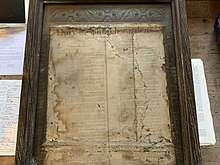
| Hereford | |
|---|---|
 Hereford Cathedral and Wye Bridge | |
.png) Coat of Arms | |
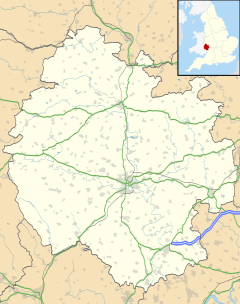 Hereford Location within Herefordshire | |
| Population | 60,415 [1] |
| OS grid reference | SO515405 |
| • London | 135.7m |
| Civil parish |
|
| Unitary authority | |
| Ceremonial county | |
| Region | |
| Country | England |
| Sovereign state | United Kingdom |
| Post town | HEREFORD |
| Postcode district | HR1-HR4 |
| Dialling code | 01432 |
| Police | West Mercia |
| Fire | Hereford and Worcester |
| Ambulance | West Midlands |
| UK Parliament |
|
An early town charter from 1189 granted by Richard I of England describes it as "Hereford in Wales".[2] Hereford has been recognised as a city since time immemorial, with the status being reconfirmed as recently as October 2000.[3][4]
It is now known chiefly as a trading centre for a wider agricultural and rural area. Products from Hereford include: cider, beer, leather goods, nickel alloys, poultry, chemicals, and cattle, including the famous Hereford breed.
Toponymy
.png)
The Herefordshire edition of Cambridge County Geographies states "a Welsh derivation of Hereford is more probable than a Saxon one" but the name "Hereford" is also said to come from the Anglo-Saxon "here", an army or formation of soldiers, and the "ford", a place for crossing a river (cf. Herford, Westphalia, with the same Saxon etymology). If this is the origin it suggests that Hereford was a place where a body of armed men forded or crossed the Wye. The Welsh name for Hereford is Henffordd, meaning "old road", and probably refers to the Roman road and Roman settlement at nearby Stretton Sugwas. Some historical documents refer to 'Hereford in Wales'.
History

Hereford became the seat of Putta, Bishop of Hereford, some time between AD 676 and 688, after which the settlement continued to grow due to its proximity to the border between Mercia and Wales, becoming the Saxon capital of West Mercia by the beginning of the 8th century.[5]
Hostilities between the Anglo-Saxons and the Welsh came to a head with the Battle of Hereford in 760, in which the Britons freed themselves from the influence of the English.[6] Hereford was again targeted by the Welsh during their conflict with the Anglo-Saxon King Edward the Confessor in AD 1056 when, supported by Viking allies, Gruffydd ap Llywelyn, King of Gwynedd and Powys, marched on the town and put it to the torch before returning home in triumph.[7] Hereford had the only mint west of the Severn in the reign of Athelstan (924–39), and it was to Hereford, then a border town, that Athelstan summoned the leading Welsh princes.[8]
The present Hereford Cathedral dates from the early 12th century, as does the first bridge across the Wye.[9] Former Bishops of Hereford include Saint Thomas de Cantilupe and Lord High Treasurer of England Thomas Charlton.
The city gave its name to two suburbs of Paris, France: Maisons-Alfort (population 54,600) and Alfortville (population 36,232), due to a manor built there by Peter of Aigueblanche, Bishop of Hereford, in the middle of the 13th century.
Hereford, a base for successive holders of the title Earl of Hereford, was once the site of a castle, Hereford Castle, which rivalled that of Windsor in size and scale. This was a base for repelling Welsh attacks and a secure stronghold for English kings such as King Henry IV when on campaign in the Welsh Marches against Owain Glyndŵr. The castle was dismantled in the 18th century and landscaped into Castle Green.
After the Battle of Mortimer's Cross in 1461, during the Wars of the Roses, the defeated Lancastrian leader Owen Tudor (grandfather of the future Henry VII of England) was taken to Hereford by Sir Roger Vaughan and executed in High Town. A plaque now marks the spot of the execution. Vaughan was later himself executed, under a flag of truce, by Owen's son Jasper.

During the civil war the city changed hands several times. On 30 September 1642 Parliamentarians led by Sir Robert Harley and Henry Grey, 1st Earl of Stamford occupied the city without opposition. In December they withdrew to Gloucester because of the presence in the area of a Royalist army under Lord Herbert. The city was again occupied briefly from 23 April to 18 May 1643 by Parliamentarians commanded by Sir William Waller but it was in 1645 that the city saw most action. On 31 July 1645 a Scottish army of 14,000 under Alexander Leslie, 1st Earl of Leven besieged the city but met stiff resistance from its garrison and inhabitants. They withdrew on 1 September when they received news that a force led by King Charles was approaching. The city was finally taken for Parliament on 18 December 1645 by Colonel Birch and Colonel Morgan. King Charles showed his gratitude to the city of Hereford on 16 September 1645 by augmenting the city's coat of arms with the three lions of Richard I of England, ten Scottish Saltires signifying the ten defeated Scottish regiments, a very rare lion crest on top of the coat of arms signifying "defender of the faith" and the even rarer gold-barred peer's helm, found only on the arms of one other municipal authority: those of the City of London.[10]
Nell Gwynne, actress and mistress of King Charles II, is said to have been born in Hereford in 1650 (although other towns and cities, notably Oxford, also claim her as their own); Gwynn Street is named after her. Another famous actor born in Hereford is David Garrick (1717–1779).
The Bishop's Palace next to the Cathedral was built in 1204 and continually used to the present day.[11][12] Hereford Cathedral School is also one of the oldest schools in England. The Harold Street Barracks were completed in 1856.[13]
During World War I, in 1916, a fire at the Garrick Theatre killed eight young girls who had been performing at a charity concert.[14]
Governance
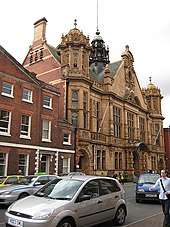
The main local government body covering Hereford is Herefordshire Council. Hereford has a "City Council" but this is actually a parish council with city status, and has only limited powers.
Historically Hereford has been the county town of Herefordshire. In 1974 Herefordshire was merged with Worcestershire to become part of the county of Hereford and Worcester, and Hereford became a district of the new county. Hereford had formed a historic borough and was reformed by the Municipal Corporations Act 1835.[15] On 1 April 1998 the County of Hereford and Worcester was abolished, and Herefordshire and Worcestershire were re-established as separate counties, although with slightly altered borders.
However the new Herefordshire was a unitary authority without any districts, and so Hereford lost its district status (although, confusingly, the authority's full legal name is the County of Herefordshire District Council). Charter Trustees were appointed to preserve mayoral traditions until a civil parish council could be set up, which happened in 2000. Hereford is one of only eight civil parishes in England which have city status.
Hereford was the name of a parliamentary constituency centring on the city, from 1295 to 2010, when it was renamed as Hereford and South Herefordshire. The current member of the House of Commons for Hereford and South Herefordshire is Jesse Norman of the Conservative Party.
Geography
Climate
As with all of the UK, Hereford experiences a maritime climate, with limited seasonal temperature ranges, and generally moderate rainfall throughout the year. The nearest Met Office weather station for which 30-year averages are available is Credenhill weather station, about 4 miles (6 km) north east of the city centre. Before 2001, the weather station at Preston Wynne (7 miles, 11 km to the north-east) provided the data.[16]
Since 2001, extremes at Hereford Credenhill have ranged from 33.6 °C (92.5 °F)[17] during July 2006, to as low as −15.8 °C (3.6 °F) during December 2010.[18]
In February 2020 many houses in Hereford were evacuated due to floods.
Transport
| Railways in Hereford | ||||||||||||||||||||||||||||||||||||||||||||||||||||||||||||
|---|---|---|---|---|---|---|---|---|---|---|---|---|---|---|---|---|---|---|---|---|---|---|---|---|---|---|---|---|---|---|---|---|---|---|---|---|---|---|---|---|---|---|---|---|---|---|---|---|---|---|---|---|---|---|---|---|---|---|---|---|
| ||||||||||||||||||||||||||||||||||||||||||||||||||||||||||||
Roads
There have been plans for many years for a north–south bypass[20] and currently the plan is for a nine-mile (14 km) dual carriageway; however, HM Government as yet has refused to grant permission or supply funds. However, the Hereford Link Road was completed in December 2017,[21] costing around £34,000,000 to build.[22] There are plans to add new homes, a university building and a transport hub to this area.[23] Hereford has been named as the UK's second slowest city with vehicles averaging speeds of 14.09 mph.
Rail
Hereford is served by a 4-platform railway station on the Welsh Marches Line which opened in 1854. Services regularly connect to Worcester, Birmingham, London, Manchester, Cardiff and other settlements in Wales. The station is currently operated by Transport for Wales. A second station, Hereford Barton, was closed and later redeveloped.
Military associations
In 1999, the British Army Special Air Service (SAS) moved from their base at Stirling Lines in Hereford since 1960 to a former Royal Air Force base RAF Credenhill in Credenhill that had been redeveloped and was designated as Stirling Lines in 2000. The clock tower on which the names of deceased SAS soldiers are inscribed was re-located.[24]
Economy
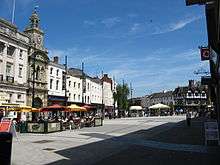
The main public service employers in Hereford include:
- Herefordshire Council
- NHS Herefordshire
In 2005 Hereford was granted Fairtrade City status.[25]
Major employers in the city include:
- Bulmers, now owned by Heineken – Cider and alcoholic beverages producer. Brands include Woodpecker Cider, Strongbow and Bulmers Cider[26]
- Special Metals Wiggin Ltd – Manufacturers of nickel alloys[27]
- Cargill Meats Europe (formerly Sun Valley) – Manufacturers and suppliers of food products for retailers and foodservice operators[28]
- Painter Brothers – Manufacturers of galvanized steel towers including The Skylon[29]
Other major companies based in Hereford include:
- Spinning Dog Brewery – Brewers of traditional beers in Hereford City
- Wye Valley Brewery – Producers of such beers as Butty Bach and Hereford Pale Ale (HPA) and other real ales.
Herefordshire is a global centre for cider production as it supports many acres of orchards, so many breweries and associated organisations exist here, along with other heavy and light industries.[30] Within the city, many are based at the Rotherwas Industrial Estate.
Regeneration
Many of the schools in Hereford have been rebuilt and improved.[31] The Herefordshire and Ludlow College has also been rebuilt to a 21st-century standard.[32] A new higher education institution NMITE (New Model Institute for Technology and Engineering)[33] is also being developed, which, once validated, will teach Engineering in a liberal context. The first staff were appointed in 2018 and the first cohort of students will enter in 2020 subject to Validation. There have also been a number of improvements at Hereford Sixth Form College, where a new business block extension was completed in 2013 and a new reception area was completed in 2015.
Hereford benefitted from the PFI reconstruction schemes for NHS hospitals, with the former County Hospital site having £60 million spent on a brand new, one-site hospital to replace the former 3 hospitals: the General, the Eye Hospital, and the County Hospital. The new Hereford County Hospital was the single largest investment in Herefordshire at that point. In 2015, further funds for more improvements at the hospital were granted.
Current and future projects
A major regeneration project is taking place in Hereford city centre, formerly known as the Edgar Street Grid. This covers an area of around 100 acres (0.40 km2) just north of the old city walls. Work started on 8 October 2012,[34] and should take around 15 years to complete the whole project. The regeneration includes the rebuilding of the canal basin at the end of the currently disused Herefordshire and Gloucestershire Canal. The £80 million phase 1 includes a supermarket, department store, multiplex cinema, shops, restaurants, and other facilities and opened in late Spring 2014.[35]
The Butter Market is also due for refurbishment and proposals are being examined.
A proposed bypass has been drawn up to circulate the city, which suffers from rush hour traffic, with potential routes either to the east or west of the city. Both routes would connect with the Rotherwas Access Road which was recently completed, connecting the Rotherwas Industrial Estate to the A49. Rotherwas itself has recently been awarded an Enterprise Zone status by the government which is expected to boost the economy and bring in thousands of new jobs.[36]
A second railway station for Hereford has been discussed, which would be situated in Rotherwas as part of the Enterprise Zone.
Hereford is due to receive half of the 20,600 new homes expected to be built in the county by 2026 as part of the Regional Spatial Strategy.[37]
Sport
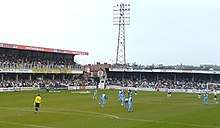
Hereford is the home of the football club, Hereford FC who play at Edgar Street in the National League North. They are a phoenix club that was set up in the wake of the demise of Hereford United Football Club in 2014. United were best known for beating Newcastle 2–1 in an FA Cup replay in January 1972, when they were still a non-league side and Newcastle were in the top division of English football. Other city clubs include Westfields and Pegasus Juniors.
Hereford Rugby Club announced plans in 2012 for a £6 million move to a new home.[38]
Hereford Hockey Club is based at the Hereford City Sports Club, with teams entered into leagues in the West Hockey Association.[39]
The city is home to Hereford Racecourse, a traditional National Hunt course to the north of the city centre which hosted around twenty meetings a year. The company who leased the site decided in 2012 that the site was not viable. What many thought to be the last meeting was held on 16 December 2012, however the course reopened for racing in October 2016.[40]
Golf courses surround the city at Wormsley (Herefordshire GC), Burghill and Brockington. The racecourse surrounds a golf course in Holmer.
Public leisure
Hereford's public leisure facilities are managed by a not-for-profit trust HALO Leisure, which runs the Hereford Leisure Centre (that includes sports halls, gymnasium, squash courts, and an outdoor athletics facility), and the Hereford Leisure Pool (which includes a gymnasium, full size swimming pool, leisure pool, diving pool, and learners pool).
Clubs and societies
The Hereford Rowing Club (along with the Kayak Club) uses the River Wye. The stretch of river is also used for other water sports. Hereford has a nine pin skittle league, formed on 24 October 1902, and today consists of five divisions.[41]
Hereford has other clubs and societies including the Railway Club, Welsh Club, Military Club, Richmond Place Club and the Whitecross Squash & Lawn Tennis Club.
Hereford has several music clubs/societies such as Herefordshire Youth Orchestra, a group for those up to the age of 21.
Education
University
Plans are now in progress to create a new higher education institution, New Model Institute for Technology and Engineering, in Hereford.[42]
Colleges
Hereford is home to five colleges, including:
- Hereford College of Arts – a publicly funded art school located on Folly Lane, with a Higher Education centre on College Road in the former main buildings of the Royal National College for the Blind. The University of Wales Trinity St Davids co-operate to provide degree qualifications.
- Herefordshire and Ludlow College (HLC) formerly known as Hereford College of Technology - The Folly Lane facility includes a university centre for the University of Worcester.
The National School of Blacksmithing is the oldest established Blacksmithing college in the UK, also the largest facility for training smiths in Europe. This is also part of HLC.[43]
- Hereford Sixth Form College
- The Royal National College for the Blind – One of the top colleges in Europe for blind and visually impaired students, and one of only two in Britain. The college occupies the former Hereford College of Education campus. The college often plays host to major blind sporting competitions like the Blind World Cup 2010 and Euro 2015 Blind Football Championships, and currently hosts the England Blind Football squad training camps.
- Holme Lacy College – An agricultural college that was part of the Pershore Group of Colleges (now Warwickshire College), but currently belongs to Herefordshire and Ludlow College (HLC).[44][45]
Schools
Hereford's many secondary schools include:
- The Steiner Academy Hereford – The first Rudolf Steiner school in England to become an Academy.[46][47]
- Aylestone Business and Enterprise College- A co-educational comprehensive school for pupils aged between 11 and 16, created in 1976 by merging two former grammar schools, the Hereford High School for Boys and the Hereford High School for Girls. Specialises in Business and Enterprise.[48]
- The Bishop of Hereford's Bluecoat School – A co-educational voluntary aided comprehensive school for pupils aged between 11 and 16, formed in 1973 from two former church secondary schools, the Bluecoat foundation, dating back to 1710 and the Bishop's School, a secondary modern school founded in 1958. It is now a Technology College with a second specialism in Languages.
- The Hereford Academy – A high school for pupils aged between 11 and 19. It was known as Haywood High School in the late seventies until 2006, when it was renamed as Wyebridge Sports College. As of 1 September 2009 it was renamed The 'Hereford Academy'.[49] It has been, like Whitecross High School, re-classified as a 'Sports College'. The Academy's new building opened in September 2011, and the demolition of the old school site, making way for new playing fields to be laid out, was completed in Spring 2012.[50]
- Hereford Cathedral School – A co-educational independent school and sixth form, and a member of the Headmasters' and Headmistresses' Conference. The earliest existing records date from 1384 though it is likely that a school was associated with the cathedral from its foundation in the late 7th century. HCS, together with HCJS (see below) educates the choristers for Hereford Cathedral Choir.
- St Marys RC High School – A Roman Catholic Comprehensive School for boys and girls aged 11–16. The school primarily serves the Catholic Communities of Herefordshire and is situated in a very attractive rural location close to the River Lugg, a few miles to the east of the City of Hereford in the village of Lugwardine.[51]
- Whitecross Hereford High School – A specialist Sports College, which moved to a brand new PFI building in June 2006. The college for pupils aged between 11 and 16 aims to use the new facility to provide the best high school education for its pupils in the topic of Sports & Fitness.[52]
Primary schools in the city include Hereford Cathedral Junior School, a co-educational independent school. Hereford Cathedral Junior School is, with Hereford Cathedral School, part of the ancient Hereford Cathedral Foundation dating back to 676. The Junior School was founded as an independent school in 1898. The City's other primary schools are: Lord Scudamore Academy, St James C of E, St Francis Xavier R.C, Trinity, Holmer C of E, Marlbrook, Riverside, St Martin's, Broadlands, Riverside, Hampton Dene and St Paul's C of E.
Health and social care
In early 2008, Herefordshire Council and NHS Herefordshire became the first local authority and Primary Care Trust to form a new kind of partnership.[53]
The major hospital in Hereford is the Hereford County Hospital. Ambulance services are provided by the West Midlands Ambulance Service NHS Trust. The Midlands Air Ambulance charity provides air ambulance services across Herefordshire.
A private national firm operates a hospital in Hereford, and the city is well populated with council-funded, private and charity based nursing, residential and other elderly care homes and facilities.
Society and culture
Agriculture
Farming has played a major part in the history of the county of Herefordshire, and for many years the City of Hereford was the epicentre, playing host to the Cattle Market; a major market site.[54]
With the 2001 foot-and-mouth outbreak the market suffered with trade reduced. Established by Act of Parliament, the market had to be provided, and so a Bill was introduced in 2003[55] to move the site to the outskirts of the city. The inner city site would then be available for redevelopment, a process that has now finished.
The new Hereford Cattle Market opened its doors in August 2011 on the site just outside the city[56] and has already proved so successful that trading and business is up on the previous site's record.[57]
Music

The annual Three Choirs Festival, originating in the 18th century and one of the oldest music festivals in the British Isles, is held in Hereford every third year, the other venues being Gloucester and Worcester.
Composer Sir Edward Elgar lived at Plas Gwyn, Eign Hill, in Hereford between 1904 and 1911, writing some of his most famous works during that time. He is commemorated with a statue on the Cathedral Close. One of his Enigma Variations was inspired by a bulldog named Dan falling into the River Wye at Hereford, and the dog is similarly honoured with a wooden statue beside the river. Not long after moving into the city he was (despite not being a city council member) offered but declined the office of mayor of the city. He also visited the city as a conductor at the Three Choirs Festival, the last occasion in 1933 prior to his death.[58]
Hereford is home to the Hereford Police Male Voice Choir who competed on the BBC TV show "Last Choir Standing",[59] and the Railway Choir.
A charity music school is also based in Hereford.[60]
The hymn tune ‘Hereford’ was written by Samuel Sebastian Wesley (1810-1876). He was an organist at Hereford Cathedral (1832-1835). This tune is often sung to the words ‘O Thou who camest from above’.[61]
Art
H.Art, or Herefordshire Art Week, is an annual county-wide exhibition held in September, displaying the work of local artists.[62] Many places usually closed to the public are opened during this week, such as the Bishop's Palace at the Cathedral.
Polish-born sculptor Walenty Pytel has had studios in Hereford since 1963 after training at Hereford College of Art.
There is a statue of a Bronze Hereford bull designed by Brian Alabaster ARBS in front of The Old House[63]
Literature
The troops of the fictional commando squad Rainbow were based at RAF Hereford, as detailed in the novel Rainbow Six.
The action of the fictional novels Shades of Grey and The Last Dragonslayer by Jasper Fforde take place in Hereford.[64]
Phil Rickman's Merrily Watkins series of supernatural and mystery novels is set in and around Hereford.[65]
Comedy writer Aaron Gillies began writing using Twitter while working as a sound technician at The Courtyard.[66]
Media
The local radio stations are Free Radio (formerly known as Wyvern FM) which broadcasts on 97.6-96.7-102.8 FM, Sunshine Radio on 106.2 FM, BBC Hereford and Worcester which broadcasts on 94.7FM, Like Radio Like Music, Like Radio. Digital Radio Station available on DAB, Online and On The Go. The station covers Herefordshire, Worcestershire, Gloucester, Cheltenham and Birmingham. Hereford FC has its own online Radio station, RadioHerefordFC covering all its matches Home and Away. It also has a 24/7 eclectic music output.
The Hereford Times is the city's only remaining weekly local newspaper as the 'Hereford Journal' ceased publication on 11 June 2014 and the 'Hereford admag' ceased publication in September 2018.
Local TV content is currently provided by BBC Midlands Today and ITV Central News.
Entertainment
The city's main theatre and cultural venue is the Courtyard Centre for the Arts which was opened in 1998, replacing the New Hereford Theatre.
There is also a multi screen Odeon cinema in the Old Market precinct.
MFA Bowl (formerly known as TGS), home to a Ten Pin Bowling alley and Mini Golf course is located near the railway station.
There is also a dedicated Skatepark on Holmer Road.
Notable people
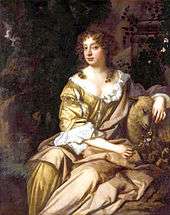
John Kemble, Catholic priest and martyr, was born near Hereford.
Nell Gwyn, David Garrick and Sarah Siddons, actors and actresses, are all historical figures popularly associated with Hereford.
Major-General Stringer Lawrence, first commander-in-chief of British troops in India, under whose command Robert Clive served, was born in Hereford.
Broadcaster Gilbert Harding was born there when his father was master of the local workhouse, as was contemporary actress Beryl Reid.
The original lineup of The Pretenders, with the exception of lead singer Chrissie Hynde, were from Hereford, as were the rock band Mott the Hoople.
Frank Oz, puppeteer for The Muppets and Yoda of Star Wars was born in Hereford and lived there for the first five years of his life.[67]
Footballer Connor Wickham was born in the city.[68]
Ellie Goulding, pop singer and songwriter was born in Hereford.
Hereford is the current home of television personality, Wincey Willis.
The highwayman William Spiggot declared before his execution to the Ordinary's Accounts[69] of Newgate Prison in London that he was the son of an innkeeper from Hereford.[70]
Tourism and attractions
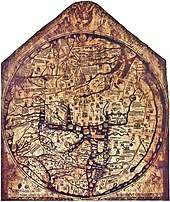
Hereford Cathedral dates from 1079 and contains the Mappa Mundi, a medieval map of the world dating from the 13th century which was restored in the late 20th century. It also has a chained library.[71]
The Old House, Hereford is an historic black and white house in the centre of High Town in Hereford. It is now a museum about life in the Jacobean era of the 1600s when it was built.
The Hereford Museum and Art Gallery, housed in a Victorian Gothic building and opened in 1874, presents artefacts, fine art, and decorative art associated with the local area.
The Hereford Cider Museum is in the city, with a shop, and an interactive guide to producing the drink. It is a registered Charity Trust founded in the early 1970s by people who wanted to record the past, and also the disappearing traditional art of cider making that had been practiced for generations on the farms in the "Cider Counties". Situated in an old cider factory, it opened in 1980 and 1981. In the spring/summer a cider festival is held, started in the mid-1980s, by the Friends of the Museum with the advice of Long Ashton Research station near Bristol. It has a display of named cider apples, and the apples are pressed in the old way. The Museum holds in its Pomological Archive a number of records pertaining to apples and cider.
The Violette Szabo Museum is in Wormelow village, outside the city.
Holme Lacy House, now a hotel for a national chain, was built near the city by John Scudamore in the 1500s. It has played host to famous historical figures in its time.[72]
Festivals
Several festivals are hosted in Hereford including the Beer on the Wye festival, the Hereford Food Festival, and the Three Choirs Festival.
Twin towns


Freedom of the City
The following people and military units have received the Freedom of the City of Hereford.
Military Units
- The Herefordshire Light Infantry: September 1945.
- RAF Hereford: April 1959.
- The King's Shropshire Light Infantry: April 1960.
- The Light Infantry: July 1971.
- HMS Antelope, RN: March 1976.
- The Royal British Legion: April 1976.
- The 22nd Special Air Services Regiment: April 1981.
- The Burma Star Association: April 1982.
- The Rifles: July 2008.
See also
- List of Hereford MPs
- Herefordshire
- Railways in Hereford
References
- https://www.citypopulation.de/en/uk/westmidlands/county_of_herefordshire/E34004334__hereford/§. Archived from the original on 5 March 2016. Missing or empty
|title=(help) - "The Royal Charters of the City of Hereford". Hereford Web Pages. Archived from the original on 15 January 2012. Retrieved 7 September 2011.
- Beckett, J V (2005). City status in the British Isles, 1830–2002, Historical urban studies. Aldershot: Ashgate.
- "Hereford City Council Charter". Herefordcitycouncil.gov.uk. Archived from the original on 12 February 2012. Retrieved 28 January 2012.
- Sims-Williams "Putta (d. c.688)" Archived 20 October 2012 at the Wayback Machine Oxford Dictionary of National Biography
- Annales Cambriae
- J and M Tonkin, The Book of Hereford, 1975
- J. Hillaby, Bishop Richard de Capella and the foundation of Herefordshire's market towns, in Woolhope Naturalists Field Club,Essays in honour of Jim and Muriel Tonkin, 2011
- "Coat of arms of Hereford (England)". Ngw.nl. Archived from the original on 15 March 2012. Retrieved 28 January 2012.
- "Archived copy" (PDF). Archived (PDF) from the original on 17 December 2010. Retrieved 6 September 2011.CS1 maint: archived copy as title (link)
- "A History of Hereford". Localhistories.org. Archived from the original on 7 January 2012. Retrieved 28 January 2012.
- "Plans to demolish former barracks in Harold Street, Hereford to build Hereford Cathedral School boarding school refused". Redditch Advertiser. 16 December 2016. Archived from the original on 24 September 2017. Retrieved 24 September 2017.
- Chester, Jerry (24 February 2014). "World War One: Hereford theatre fire killed eight at fundraiser". BBC Online. Archived from the original on 3 March 2014. Retrieved 27 February 2014.
- Vision of Britain – Hereford MB Archived 9 January 2006 at the Wayback Machine
- Office, Met. "Hereford climate". www.metoffice.gov.uk. Archived from the original on 6 September 2015.
- "July 2006 Maximum". Archived from the original on 24 July 2011. Retrieved 2 March 2011.
- "December 2010 minimum". Archived from the original on 24 July 2011. Retrieved 2 March 2011.
- "Archived copy". Archived from the original on 29 January 2016. Retrieved 12 August 2015.CS1 maint: archived copy as title (link)?
- "Hereford Times". Hereford Times. 27 February 2009. Archived from the original on 4 April 2012. Retrieved 28 January 2012.
- Council, Herefordshire. "Hereford 2020". www.herefordshire.gov.uk. Archived from the original on 20 April 2019. Retrieved 20 April 2019.
- "New £34m city link road opened". 18 December 2017. Archived from the original on 20 April 2019. Retrieved 20 April 2019.
- Hereford_2020 (7 February 2018), City Link Road - post regeneration, archived from the original on 5 November 2019, retrieved 20 April 2019
- Staff (19 May 1980). "World: Britain's SAS.: Who Dares Wins". Time. Archived from the original on 20 January 2011. Retrieved 9 January 2011.
- "Fairtrade status given in county". BBC News. 6 March 2005. Archived from the original on 17 September 2011. Retrieved 10 December 2007.
- "Bulmers – Getting things ready for 2012 (winter)". Bulmer.com. Archived from the original on 19 October 2013. Retrieved 28 January 2012.
- "Special Metals Wiggin Ltd". www.specialmetals.com. Archived from the original on 21 April 2008. Retrieved 16 August 2008.
- "Cargill Meats Europe". www.cargill.com. Archived from the original on 1 August 2008. Retrieved 16 August 2008.
- "Painter Brothers". www.painterbrothers.com. Archived from the original on 21 September 2008. Retrieved 16 August 2008.
- "Update: UBL Ledbury - Cider production to shift to Hereford". Hereford Times. Archived from the original on 7 April 2014.
- "BBC News". BBC News. 7 August 2009. Retrieved 28 January 2012.
- "Herefordshire College of Technology". Hct.ac.uk. Archived from the original on 24 January 2012. Retrieved 28 January 2012.
- "Archived copy". Archived from the original on 4 April 2019. Retrieved 18 November 2019.CS1 maint: archived copy as title (link)
- "Work Starts on Hereford's Old Cattle Market". Herefordtimes.com. 2 August 2011. Archived from the original on 4 April 2012. Retrieved 28 January 2012.
- "Stanhope PLC". Stanhope PLC. 5 January 2011. Archived from the original on 30 March 2012. Retrieved 28 January 2012.
- "Rotherwas named Enterprise Zone". Bbc.co.uk. 17 August 2011. Archived from the original on 4 September 2015. Retrieved 28 January 2012.
- "West Midlands Regional Spatial Strategy". Wmra.gov.uk. 31 March 2010. Archived from the original on 28 December 2011. Retrieved 28 January 2012.
- Woodman, Ian (1 September 2011). "Planning permission for new club". Pitchero.com. Archived from the original on 22 October 2012. Retrieved 28 January 2012.
- "Hereford Hockey Club". Pitchero.com. 13 October 2014. Archived from the original on 17 October 2014. Retrieved 13 October 2014.
- "Hereford: Horse racing returns after four-year absence following closure". BBC Sport. Archived from the original on 10 October 2016. Retrieved 6 October 2016.
- "Hereford Skittles Club". Herefordskittles.org. Archived from the original on 16 March 2012. Retrieved 28 January 2012.
- https://nmite.ac.uk/
- "HCT Rural Crafts Centre". Hct.ac.uk. Archived from the original on 31 January 2012. Retrieved 28 January 2012.
- "Holme Lacy College". Pershore.ac.uk. Archived from the original on 28 July 2007. Retrieved 28 January 2012.
- "Holme Lacy Campus". Hct.ac.uk. Archived from the original on 24 January 2012. Retrieved 28 January 2012.
- "Steiner Academy Hereford". Steineracademyhereford.eu. Archived from the original on 14 December 2011. Retrieved 28 January 2012.
- Anthroposophy
- "Aylestone School". Aylestone.hereford.sch.uk. Archived from the original on 7 February 2012. Retrieved 28 January 2012.
- "The Hereford Academy Official Website". Theherefordacademy.org.uk. Archived from the original on 6 March 2012. Retrieved 28 January 2012.
- "The Hereford Academy's New Building". Theherefordacademy.org.uk. Archived from the original on 6 March 2012. Retrieved 28 January 2012.
- St. Marys RC High School Archived 2 August 2010 at the Wayback Machine
- "Whitecross High School & Sports College". Whitecross.hereford.sch.uk. Archived from the original on 10 February 2012. Retrieved 28 January 2012.
- "Who are we?". Herefordshire.nhs.uk. 11 January 2010. Archived from the original on 15 March 2011. Retrieved 28 January 2012.
- "Cattle Market history". Bbc.co.uk. 13 June 2011. Archived from the original on 25 June 2011. Retrieved 28 January 2012.
- "Hereford Markets Act 2003". Legislation.gov.uk. 30 October 2003. Archived from the original on 7 January 2012. Retrieved 28 January 2012.
- "New Cattle Market". Bbc.co.uk. 16 June 2011. Archived from the original on 25 June 2011. Retrieved 28 January 2012.
- "Hereford livestock market move a 'success'". BBC News. 22 November 2011. Archived from the original on 25 November 2011.
- Hereford 800, A Celebration. Revelstone Publishing Ltd. 1989. pp. 44–45, 47. ISBN 1-871817-20-X.Articles, Edward Elgar's Hereford by Jacob O'Callaghan, and The Three Choirs Festival by Graham J. Roberts.
- "BBC Last Choir Standing". Bbc.co.uk. Archived from the original on 30 October 2012. Retrieved 28 January 2012.
- "Music School | Regenerating Hereford City and County". Herefordfutures.co.uk. Archived from the original on 3 December 2011. Retrieved 28 January 2012.
- "HEREFORD (Wesley)". Hymnary.org. Archived from the original on 1 January 2018. Retrieved 31 December 2017.
- "H.Art Week". H-art.herefordshire.gov.uk. Archived from the original on 21 January 2012. Retrieved 28 January 2012.
- "Hereford High Town life-sized bull statue installed". 13 July 2012. Archived from the original on 20 April 2016 – via www.bbc.co.uk.
- Fforde, Jasper. "Shades of Grey - sleuth". www.jasperfforde.com. Archived from the original on 19 August 2010.
- Knight, Adam (20 November 2014). "Major ITV drama to be set and filmed in Herefordshire". Hereford Times. Archived from the original on 13 December 2015. Retrieved 11 February 2016.
- May, Philippa (4 December 2015). "Tweets lead to publication". Hereford Times. Archived from the original on 13 December 2015. Retrieved 11 February 2016.
- "Frank Oz". IMDb. Archived from the original on 26 December 2008.
- Morgan, Ian (14 May 2010). "Bright future ahead for Ipswich Town's Connor Wickham". Hereford Times. Archived from the original on 4 April 2012. Retrieved 16 May 2010.
- Emsley, Clive; Hitchcock, Tim; Shoemaker, Robert. "The Proceedings - Ordinary of Newgate's Accounts". Old Bailey Proceedings Online. 7.0. Archived from the original on 15 October 2015. Retrieved 28 October 2015.
- "Ordinary of Newgate's Account, February 1721 (OA17210208)". Old Bailey Proceedings Online. 7.2. Archived from the original on 26 December 2015. Retrieved 28 October 2015.
- "Mappa Mundi". Herefordcathedral.org. Archived from the original on 26 January 2012. Retrieved 28 January 2012.
- "Warner Holidays". Warnerleisurehotels.co.uk. Archived from the original on 1 March 2012. Retrieved 28 January 2012.
- "Archived copy". Archived from the original on 5 July 2013. Retrieved 20 July 2013.CS1 maint: archived copy as title (link)
- https://www.herefordshirehistory.org.uk/archive/herefordshire-images/people-and-portraits/146836-john-masefield-freedom-of-the-city-of-hereford-ceremony-1930
- https://www.bbc.com/news/uk-england-11661620
- https://herefordcitycouncil.gov.uk/city-history/freedom-of-entry/
External links
| Wikimedia Commons has media related to Hereford. |